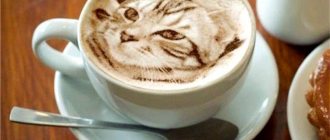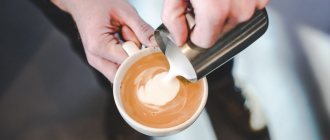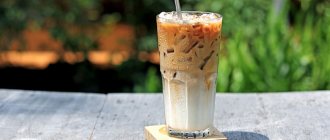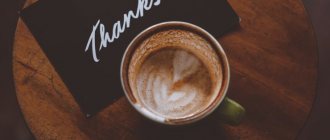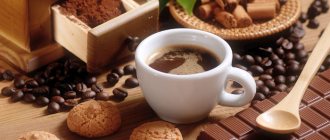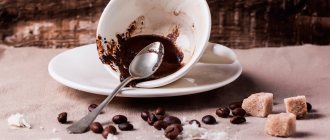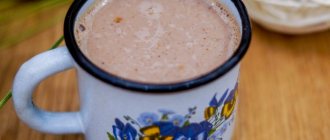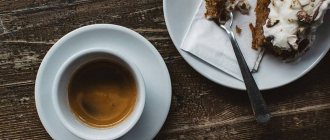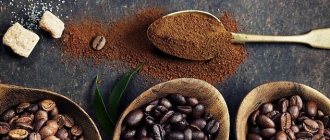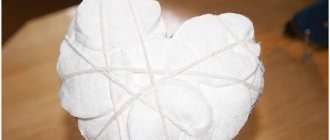You've probably tried coffee with patterns and paintings on the foam at least once in your life!? This technique, called latte art among professionals, turns the procedure of creating cappuccino into a real art.
Coffee with a pattern on the foam not only gives a pleasant taste sensation (as it is sprinkled with spices), but also pleases with its unusual appearance. All professional baristas without exception learn the art of its preparation, but very few manage to reach real heights. Today we will reveal the secret of preparing artistic compositions with coffee foam and talk about the works of the best masters.
How to draw latte art on coffee foam?
First, let’s figure out what kind of coffee baristas use to draw artistic compositions. Most often, masters use cappuccino, which is prepared by adding milk with thick foam to espresso in a ratio of 1 to 3. Depending on the pattern and the method of creating it, grated chocolate, cinnamon and other ingredients can be added to the cup.
For drawing, the most common choice is full-fat milk with a high content of cream, which gives it a unique taste. However, high fat content is not a necessary requirement - good foam can be obtained by whipping skim, baked and even soy milk.
But the processing method at the factory is really important. Modern industry offers two types of products - traditionally pasteurized and sterilized (ultra-pasteurized). Pasteurization involves heating to 60 °C for an hour. During ultra-pasteurization, the product is briefly heated to 120 °C and immediately cooled. Thanks to this, the shelf life increases from 10 days to six months, but the product partially loses its original structure. That's why pasteurized milk is used for latte art.
Foaming is done using hot steam, which the barista should always have in abundance. The result should be a thick and viscous drink, reminiscent of melted ice cream in consistency. At home, you can do without a coffee maker with a steamer. A French press works well for whipping. Using this tool you can create a product that is quite suitable for drawing.
Another important condition is the temperature of the cappuccino. It should not exceed 60 °C, otherwise the milk protein will begin to break down and precipitate. In addition, at high temperatures, carbon compounds degrade, causing the taste of the drink to turn from pleasantly sweet to bitter. So, if you want to drink something hot, it is better to take plain black coffee.
Varieties of coffee art
There are three basic areas of latte art that you need to master before taking on more complex patterns.
A heart is the easiest way to draw. First, you need to pour the cream into the coffee through the pitcher so that it spreads in the center of the circle. To turn a simple circle into a heart, just cross it out with a thin stream in the middle.
To get an apple, the drawing is drawn from the edge of the coffee cup, depicting an apple twig. Then simply add cream to the circle in the center of the cup.
Latte art technique
Now let's look at the most important question - how to make a beautiful design on coffee foam? To create artistic compositions, a metal cup with a spout is used - a pitcher, also called a milk jug. The master may also need other tools for latte art: a pastry syringe, thin nozzles for it, sticks of different shapes and lengths, with the help of which the drawing is adjusted.
The first stage involves mixing milk, espresso and foam. To do this, the cup is tilted until a fairly deep place appears. The milk and foam must be thrown exactly into the deepest point. The master's main task is to carefully break the surface of the coffee and prevent it from ricocheting off the bottom of the cup. If everything is done correctly, natural mixing of the components will occur. You may not be able to perform this operation the first time, so before demonstrating your newly acquired skills to someone, practice well.
Next, repeated mixing is carried out, called “swing”. During this procedure, the latte artist moves the pitcher over the cup, slowly pouring milk until the drink is finally ready for further drawing. And finally, the last step is to create the image. There are many techniques for painting on coffee foam that are worth considering in more detail.
Tip 3. How to properly hold the stencil over the cup?
The main rule of aesthetic decoration is that under no circumstances should the stencil touch the coffee or its foam. If you have carefully prepared the coffee, observing all the proportions, then the stencil for decorating the coffee can simply be placed on the cup.
However, if the coffee foam is too voluminous, you will have to hold the stencil suspended with one hand while sifting the cocoa or cinnamon with the other. In general, the closer the stencil is to the foam, the clearer and more understandable the design will be.
Perhaps the hardest part about using a coffee stencil is learning how to carefully hold the design over the foam without touching it. If at first it seems to you that there is a danger of smearing the foam, when decorating the coffee, place the cup at eye level or try working together.
Methods for creating latte art drawings
Baristas use three techniques for applying images to coffee foam:
- • Stencil method;
- • engraving method (pitching);
- • etching.
Stencil method
The easiest way to create a beautiful design is using a stencil. To do this, a circle is made from cardboard, with a cut out shape and placed on a cup. The design is created using powdered sugar, cocoa, cinnamon or chocolate.
Engraving method
This is a more complex method that involves the use of a pitcher and other devices to decorate the latte. The essence of the procedure is to smoothly pour milk onto the surface of the coffee foam. In this case, the pitcher must be as close as possible to the surface layer of the drink, otherwise the milk will simply drown.
Beginners often ask the question: “How to draw a design on coffee with chocolate topping?” Indeed, a pitcher and other traditional tools will not help here. Professional baristas use a pastry syringe with a fine nozzle. In addition to topping, they can be used to dose syrups and any other viscous substances.
Etching
You've probably noticed how baristas in restaurants deftly use small chopsticks or even ordinary toothpicks. At this moment they demonstrated etching - drawing with sharp objects. The essence of the method comes down to immersing grated chocolate, cinnamon, and any other ingredients that act as a toner in foam and then shaping the resulting dark spots into the desired patterns.
Tip 2. What should be the stencils for coffee?
The diameter of the stencil should be slightly larger than a cup. Disposable stencils for confectionery products are easy to make: just print one of the pictures offered on the Internet and then cut out the light areas with scissors.
It is important that the stencil has a tail, by which it can be carefully pulled and removed from the cup. To make a reusable stencil, instead of paper, take cardboard and, after cutting, cover it with tape, or better yet, immediately take plastic, for example, a yogurt lid.
It is not easy to process thick cardboard, and especially plastic, with scissors and tape. Therefore, it is often much easier to buy coffee stencils than to make them yourself. Online stores today offer a wide variety of stencils for painting on coffee, including in sets. Their themes can be very diverse, and the drawings are specially designed to be easy to read and last a long time on the foam. You will find beautiful stencils in our catalog.
The most unusual drawings on foam
If you're interested in latte art, you'd probably like to learn how to make beautiful color drawings on coffee or learn some other exciting techniques. Especially for you, we decided to tell you about the techniques of the world's best baristas.
A group of Japanese artists have come up with a method for creating three-dimensional latte art. The authors of the technique modestly declare that the secret lies only in special frothing of the milk. However, not a single professional coffee maker has yet been able to completely copy the creations of the Japanese.
South Korean barista Lee Kang-bin has figured out how to make colored latte art. He called his technique “art cream”, contrasting it with traditional latte art, which uses only two shades. The Korean's unusual creations have brought him stunning popularity - on the official Instagram page alone there are more than 200 thousand subscribers. That being said, Lee Kang-Bin's creations truly deserve admiration. The barista managed to transfer the Mona Lisa, Van Gogh's Starry Night, Edvard Munch's The Scream and many other creations of great painters to the surface of the coffee.
The secret of the art cream technology lies in the use of light colored glaze and incredible manual dexterity. The drawing is applied using a pitcher and special spoons. But the Korean also actively uses etching. On his workbench there are always several special tools for giving plastic glaze desired shapes.
Latte art is attracting more and more attention both among professional restaurateurs and among ordinary coffee lovers. Today it can rightfully be called original art, which can compete with graphics, painting and even sculpture.
Making basic shapes using coffee
To help the novice decorator of an invigorating drink, detailed instructions for applying the most popular and simple patterns using the pitching technique are given below.
heart
To decorate a drink with this design, you need to:
- Holding the pitcher at a distance of 5 cm from the surface of the coffee, pour a little foam into the middle of the cup to create a white circle.
- Bring the mug's spout closer to the surface.
- Bring it down sharply through the center of the circle.
The milk foam will stretch in the direction of movement of the instrument. The circle will split in half. The starting point of the division will fall below the circle, and the end point will move down. The result will be a heart.
Bunny
To decorate coffee with such a pattern, pitching and engraving techniques will be used. To draw a rodent, proceed as follows:
- A large circle of foam is drawn just below the middle of the cup. This will be the face of the beast.
- In the free space, a heart is drawn using the pitching technique. The sharp end should be in contact with the muzzle. These will be the rodent's ears.
- Using a toothpick, draw eyes, nose, and mustache with coffee foam.
Star
The decoration algorithm is as follows:
- Milk foam is poured into the center of the cup from the pitcher in the form of a circle.
- Using a syringe filled with chocolate glaze, trace the outline of the white spot.
- The second chocolate rim is made in the same way, but a little larger.
- Using a toothpick, draw stripes from the center to the edges of the cup.
The number of rays of the star depends on the number of lines made with a wooden stick.
Apple
The sequence of actions is as follows:
- A circle is depicted in the center on the surface of the coffee.
- Place a point with the pitcher near the edge of the cup.
- With a sharp movement of the spout, direct the stream downwards, crossing the circle to its middle. This is how the fruit stalk is formed.
- A small circle is drawn in the upper free part near the stalk.
- Bring the pitcher's nose closer to him.
- With a sharp movement, they cross out the circle with a jet, bringing the end point to the stalk. This way you get 2 apple leaves.
DIY coffee stencils step by step process
It’s easy to make coffee stencils with your own hands. To learn latte art, you don't need to put in a lot of effort.
You need to have the required number of suitable templates. You can simply print the drawings you like on thick paper. Glue the template onto the cardboard more tightly and cut out the design itself using a sharp and thin stationery knife.
Make the stencil shape round, not forgetting the small handle. The diameter of the circle should match the diameter of the cup. Attach the finished stencil to a cup of poured coffee. Gently sprinkle the image with cinnamon, cocoa or finely grated chocolate.
Instead of homemade stencils, you can use a cappuccino decorator. Tin forms are suitable for reusable use.
LiveInternetLiveInternet
Latte art
(from Italian.
Latte art
, “milk” + “art”) is a special way of pouring frothed milk into espresso, thereby creating various patterns on the surface of the coffee. You can simply draw a picture on the top layer of foam with any sharp object. It is unknown who first came up with the idea of drawing on coffee, but now nothing can stop the bartenders.
The milk is whipped in a certain way until it reaches a temperature of 65-67 °C. The result should be a homogeneous foam of creamy consistency. When milk is poured into coffee, the milk foam mixes with the coffee and forms intricate patterns. The process of pattern formation is kept under the strict control of the barista. The milk should be without large bubbles. The quality of the espresso is also very important, the coffee should be brewed for 20 to 30 seconds so that its color turns red-brown.
At first, for beauty, they simply pierced a few holes in the cappuccino foam or sprinkled it with cinnamon. Then, to the delight of their clients and themselves, the baristas (coffee bartenders) came up with the idea of drawing three main shapes with the help of pitchers (milkmen): “apple”, “heart” and “leaf” - “Rosetta”. And away we go... Animals, flowers and even silhouettes of girls began to appear on the coffee foam. All these experiments resulted in a whole direction, and that’s how latte art
– the art of painting on the surface of coffee.
Nowadays, the best coffee bartenders gather for annual coffee painting championships. There, coffee gurus create new designs and technologies for their application. The highest aerobatics is considered to be the Taj Mahal, invented by Australian barista George Sabbads. One of the last world championships in latte art was won by Australian Scotty Kalaghan, who decorated 6 cups with an identical design, drawing behind his back. And the world record today is 7 roses “blooming” in a 150 ml cup of cappuccino.
Latte art technology
To draw, you need to prepare espresso coffee and high-quality milk foam. It turns out that it's all about her bubbles. Before preparing the foam, the milk is cooled to 2-4 degrees. After this, a modern coffee maker equipped with a steamer is used. Through this device, steam is supplied under pressure, which heats and whips the foam. The milk should have time to warm up to 60-70 degrees, but no more. Then part of the milk will turn into dense, tender and, most importantly, fine bubble foam. Milk frothed by any other method will only produce large bubbles. On such foam the pattern will quickly settle and spread out. High-quality foam retains its pattern for 10-12 minutes. Even if most of the coffee is drunk during this time, the pattern will settle to the bottom of the cup, almost unchanged.
Before pouring the frothed milk into the coffee, it should sit in the milk jug for 30 seconds. After this you can draw. According to the Italian method (pitching) - a coffee or milk stream. When making cappuccino, drawing begins with the first drop of milk foam that falls on the coffee. If we are talking about a coffee latte, then they draw a stream of coffee over the milk foam. You can also draw in the Australian way (etching), using, in addition to the pitcher, any available means: wooden skewers, Chinese chopsticks, coffee spoons, chocolate and fruit syrups, cinnamon, etc.
Secrets from the barista
— If you sprinkle cocoa powder on your coffee, the design will be brighter. You must also understand that coffee prepared in a coffee maker already has foam ( creama)
). Thanks to it, cocoa will not mix with coffee, but will color the milk foam beige. — The most important thing is to know exactly the laws of life of foam. For a barista, it is an elementary truth that a sharply drawn line-stream “pulls” the pattern in the direction where the last drop fell. You also need to get comfortable with the pitcher, this comes only after two or three months of hard training. If you tilt the pitcher too low towards the cup, too much foam will get into it, and if it is too high, the coffee will be filled with milk without foam. The pitcher must be held in such a way that both foam and milk pour out of it evenly - only in this situation can the pattern be obtained and the coffee not lose one of its ingredients. At the moment of infusion, it is best to imagine that the pitcher's spout is a pencil with which the barista draws.
Baristas are confident that drawings can “cultivate” the taste of coffee. Depending on the design, the crema (coffee foam) is positioned differently, in which the main taste is concentrated. For example, in the classic version of the “heart”, by pouring milk into the center of the cup, the cream is evenly nailed to the walls, enhancing the aroma and bitterness of the coffee. For those who like a mild taste, you can pour a little milk into the espresso, mix it with the cream, draw a leaf on this base, and the bitterness will go away.
In modern latte art, various techniques are used: - A stroke with a toothpick or a thin stick on the surface of the milk; instead of dye, a dark dot on the surface is used, which remains after pouring into a cup of espresso when preparing a latte. — Creation of special stencils that allow you to reproduce silhouettes from cocoa powder on milk. — Painting the surface of milk with syrups or “edible” paints. Regular syrups, which are used in bars and coffee shops, are not suitable for this purpose because they are too dense and drown in milk. Latte artists usually prepare special syrups with the addition of a small amount of starch.
The designers decided to completely wean humanity from drinking coffee, forcing them to just admire the foam. For this purpose, Oleksiy Pikalo from Boston has developed a special coffee Latte Art Printer
, which will apply any high-precision pattern to the foam of your coffee
History of appearance
Latte art appeared in the homeland of espresso Italy in the 80s of the last century. History has not preserved the name of the first barista who came up with the idea of decorating coffee with an intricate design, but the fashion for this unique art has spread far beyond the country’s borders.
In the United States, the technique was popularized by David Schomer, owner of the Espresso Vivace cafe in Seattle, Washington. The inspiration was a photograph from Italy that showed a cup of espresso with a fern design. Shomer created his own school for teaching baristas various techniques for creating images using milk and coffee foam.
By the 2000s, latte art had become popular throughout Europe, and then spread to Southeast Asia, where the technique was improved, giving it new colors. One of the most famous masters is Korean barista Lee Kang Bin, who uses coffee to create paintings by classical artists, images of Disney cartoon characters and portraits of coffee shop visitors. To obtain different colors and achieve high detail, the artist adds food coloring to the milk and uses a set of thin brushes.
The latte art craze has been linked to an increase in overall consumer awareness of coffee. A beautifully designed drink demonstrates the professionalism of the barista and his attention to the client.
An additional impetus for the development of art was the widespread use of social networks. Videos of the winners of the World Latte Art Championship collect millions of views on public video services.
